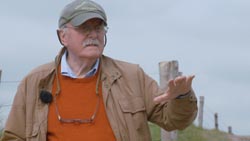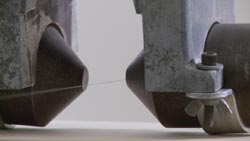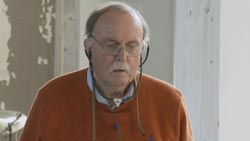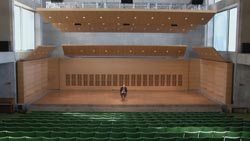| ALVIN LUCIER
NO IDEAS BUT IN THINGS A battery of percussion instruments is made to sound by the pulses of enormously amplified brain waves. Stuttering speech is transformed into the resonant frequencies of a room. Blindfolded walkers maneuver through spaces following – in the manner of bats – only the sounds of short clicks and their echos. The natural radiophonic activity of the Earth's ionosphere and magnetosphere is made audible as sferics and whistlers. A room-length stretch of wire is caught between the jaws of a magnet and plays a continuously changing drone of complex tones in an ever unexpected variety of unfamiliar but clearly harmonic relationships. The beating created by instrumental or vocal tones of slightly different frequencies creates rhythms in paradoxical tempi. Household objects, like coffee tins or matchbooks, struck and amplified, become instruments of great timbral depth and variety. The lid of a teapot is opened and closed to filter the spectra of the tones of a familiar tune emerging from within. The outlines of mountain ranges are turned into craggy melodies.
The music of Alvin Lucier doesn't begin with a musical convention or an abstract compositional notion – an idea – but begins instead with the nature of sound itself. Lucier's task, as a composer, is that of finding circumstances for sounds to largely determine their own shape in time as part of a unique musical form, not pushing and fitting the sounds into conventionally expressive musical continuities, but discovering musical continuities that optimally project and express aspects of the sounds that those conventions often hide. LISTENING TO THE WORLD
There is far more music in the world – whether of natural or human origin – than those sounds which we usually label as 'musical'. Alvin Lucier (born in Nashua, New Hampshire in 1931) is a composer for whom the discovery of the musical in under-explored regions of the heard world is more important than the imposition of his own expressive inventions; it might be said that he is a composer who listens first (and most) and composes last (and least.) Listening first means a readiness to engage with this overlooked music, whether it comes from sounds marginalized in everyday music making (like the beats of mistuned unisons) or sounds which have no prior musical status (like atmospheric noises, brain waves, or the resonances of a tin can.) Composing last means that the imposition of a compositional design comes only as the result of an intense search for the best way to make an acoustical phenomenon both clear and vivid to the listener.
Some of this music is found in sounds simply waiting to be attended to: Lucier's work with atmospheric sounds, is, to date, focused on the open-ended project of collecting field recordings in remote areas using handmade antennae, without the end-object of a concert-ready piece – requiring a beginning, middle, and end –in the offing. Other sounds require a bit more coaxing into existence and composerly shaping into musical forms. MAKING IT VIVID
Minimalism in the visual arts was defined first – and still, most to the point – as the elimination of distractions. This definition still has the best fit for the minimalist impulse in radical music making as well. Attenuating or eliminating non-salient or non-essential features in a musical sound, sound complex or succession of sounds is a valuable tactic for framing and focusing attention on the particular aspect or quality of the sound to which a composer, player, or listener wishes to call attention. This is not an unfamiliar technique – think of how a great interpreter like Frank Sinatra would “throw away” parts of a tune or lyric, to give emphasis to the remainder. The pleasant paradox of the minimalist tactic is that, when applied optimally, it does not make less of phenomena but instead allows the audience hear more by making it possible to hear features and details that were otherwise lost.
This film is punctuated regularly by excerpts from one of Lucier's central works, I am sitting in a room, in which a number of the composer's key means for working with sounds are illustrated. These include recording, reiteration, and the resonating, shaping and transforming of sounds. Recording is now so ubiquitous, so ordinary, that we scarcely give it any thought, and yet here is an instance in which we are intensely reminded that a performance and the playback of its recording are two very different events, a shift in time (as Beckett's Krapp also reminds us) as well as in quality (is it live or is it Memorex?) Lucier uses reiterations of the recording and playback process to create a formal rhythm, those shifts in time (and the regularity of that rhythm is a quality which runs deep in Lucier's music), allowing a listener to measure her progress through the piece and heightening expectations of both regularly returning memories and a forward moving process of transforming those memories into something else altogether. For these reiterations are not repetitions but gradual developments in a process of turning one sound into another, in this case the composer's own spoken voice activates and is gradually replaced by the resonances of the room, while at the same time, those resonances are given a shape in time by the rhythms of the speech. I am sitting in a room is a rare example of a work of music in which a strict, rational process and the materials (which have an emotional, even dramatic, quality to them) are in perfect balance. MAKING IT CLEAR
Lucier has long taught music – not only composition, but also the history and practice of electronic and experimental music and traditional subjects like harmony and music history, also achieving prominence as choir director at Brandeis University in the 1960s – with more than forty years tenure at Wesleyan University in Middletown, Connecticut. In one of the most engaging sections of the film, we can observe Lucier at work in a Wesleyan classroom with undergraduate students presenting their first compositions. We see a composition teacher for whom style or genre is not the central concern but rather getting at the essence of a student's ideas, in this case going directly into the economy of her piece's consumption of pitches, gently suggesting a way to make the piece better convey her own ideas. COMPOSING AND LISTENING
In Bird and Person Dyning, Lucier moves purposefully through a room, listening to the imitation bird call of an electronic Christmas tree ornament through stereophonic microphones placed in his ears, creating a feedback loop determined by his position in the space relative to the bird call and the loudspeakers as well as subtle elements of timing, so that we have the unique experience of observing a composer listening and composing the continuity of a piece of music in real time. This film is a portrait of a composer at work and it is striking here how much of that work is simply listening … Finally, allow me to note that the filmmakers here perform a bit of framed perception entirely in the spirit of Lucier's own, with one of the most breathtakingly beautiful direct cuts I've ever seen in a film, cutting from the gently oscillating surface of Music on a Long Thin Wire to the gently oscillating surface of Lake Zug. With that conjunction of images, connecting two surfaces tensely suspended between stillness and motion, the film underlines precisely the same quality in the musical work, reminding us also that musical continuity is similarly suspended.
Daniel James Wolf
Frankfurt am Main, July 1, 2013
| | THE FILM 
TEXT BY DANIEL JAMES WOLF 
FILMMAKERS’ NOTES 
DESCRIPTION OF PIECES 
MAKING OF PHOTOS 
DIRECTORS 
ALVIN LUCIER 
TRAILER 
CREDITS 
NEWS 
CONTACT 
| |







